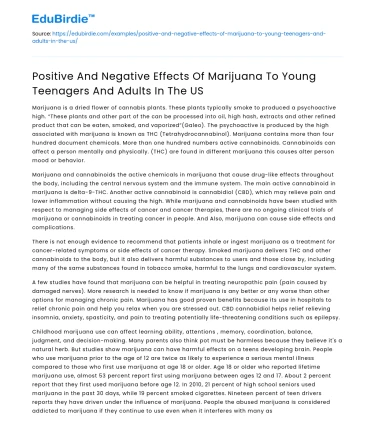Introduction
In recent years, the legalization of marijuana in the United States has become a topic of intense debate and analysis. As of 2023, more than half of the states in the U.S. have legalized marijuana for medical purposes, with several also permitting its recreational use. This shift in policy has been driven by changing public perceptions, potential economic benefits, and evolving legal landscapes. Advocates argue that marijuana legalization can lead to substantial economic growth, enhanced medical treatment options, and reduced criminal justice expenditures. However, critics caution against potential public health risks, increased substance abuse, and the social implications of widespread accessibility. This essay aims to explore both the positive and negative effects of marijuana legalization in the U.S., examining its multifaceted impact across various domains.
Economic and Medical Benefits
The legalization of marijuana has had a significant positive impact on the U.S. economy and the medical field. Economically, the cannabis industry has emerged as a substantial contributor to state revenues. According to a report by New Frontier Data, the legal cannabis market in the U.S. was valued at approximately $17.5 billion in 2020, with projections reaching $41 billion by 2025. This burgeoning industry has created thousands of jobs, from cultivation and distribution to retail and ancillary services, thereby reducing unemployment rates in several states. Additionally, tax revenues generated from marijuana sales have funded public services, education, and infrastructure improvements.
Save your time!
We can take care of your essay
- Proper editing and formatting
- Free revision, title page, and bibliography
- Flexible prices and money-back guarantee
Medically, marijuana has demonstrated potential in treating various conditions, offering an alternative to traditional pharmaceuticals. A study published in the Journal of the American Medical Association found that cannabis can be effective in managing chronic pain, a significant concern given the opioid epidemic in the U.S. Moreover, medical marijuana has been beneficial for patients with epilepsy, multiple sclerosis, and chemotherapy-induced nausea, providing relief where conventional treatments have failed. This therapeutic potential has spurred further research into cannabis-derived compounds, such as cannabidiol (CBD), which are being explored for their efficacy in treating mental health disorders and neurodegenerative diseases.
Transitioning from the economic and medical advantages, it is crucial to consider the arguments presented by opponents of marijuana legalization. While economic and therapeutic gains are noteworthy, the potential societal and health-related drawbacks warrant careful examination.
Public Health Concerns and Social Implications
Despite its advantages, marijuana legalization poses several public health challenges and social concerns. One major issue is the potential increase in substance abuse and dependency. The National Institute on Drug Abuse (NIDA) reports that approximately 30% of marijuana users may develop a use disorder, which can lead to significant long-term health and social problems. With increased accessibility, particularly among adolescents, there is a heightened risk of impaired cognitive development and mental health issues, including anxiety and depression.
Furthermore, marijuana's impact on public safety and road traffic accidents cannot be overlooked. Several studies have indicated a correlation between marijuana use and impaired driving abilities, similar to alcohol. The Governors Highway Safety Association reported an increase in traffic fatalities involving drivers who tested positive for marijuana. This raises concerns about the adequacy of current measures to manage and regulate marijuana-impaired driving effectively.
Socially, marijuana legalization has led to complex dynamics in law enforcement and community relations. While legalization has reduced minor drug offenses, disparities in enforcement and arrest rates persist, disproportionately affecting minority communities. These social implications necessitate ongoing dialogue and policy adjustments to ensure equitable outcomes for all populations. The examination of these challenges highlights the complexity of marijuana legalization, necessitating a balanced approach to policy formulation.
Regulatory Challenges and Counterarguments
In addition to public health and social issues, regulatory challenges pose significant hurdles in the implementation of marijuana legalization. The inconsistency between state and federal laws creates a legal gray area, complicating enforcement and compliance efforts. Businesses operating legally under state laws remain vulnerable to federal interventions, impeding the industry's growth and stability.
Opponents of marijuana legalization often cite the potential for increased illicit market activity as a counterargument. Despite legal avenues, illegal sales persist, driven by factors such as price discrepancies, taxation, and regulatory burdens. A study by the RAND Corporation found that the illicit market continues to supply a significant portion of cannabis, undermining the objectives of legalization. Addressing these regulatory challenges requires comprehensive policy frameworks that balance taxation, accessibility, and enforcement to curtail illicit activities effectively.
Through examining these counterarguments and regulatory challenges, it becomes evident that while marijuana legalization offers several benefits, it also presents complex issues that require nuanced solutions. The interplay between state and federal laws, alongside ongoing public health and social concerns, underscores the need for continued research and policy evaluation.
Conclusion
In conclusion, the legalization of marijuana in the United States presents a multifaceted landscape of benefits and challenges. Economically, it has generated significant revenue and employment opportunities, while medically, it offers promising alternatives for patients with chronic conditions. However, public health concerns, such as increased substance abuse and impaired driving, alongside social implications, necessitate careful consideration and ongoing policy adjustments. Regulatory challenges further complicate the landscape, highlighting the need for a balanced approach that addresses both the potential benefits and drawbacks of legalization. As the U.S. continues to navigate this complex issue, it is essential to prioritize research, education, and equitable policy-making to ensure that the positive impacts of marijuana legalization are maximized while mitigating its negative effects.






 Stuck on your essay?
Stuck on your essay?

